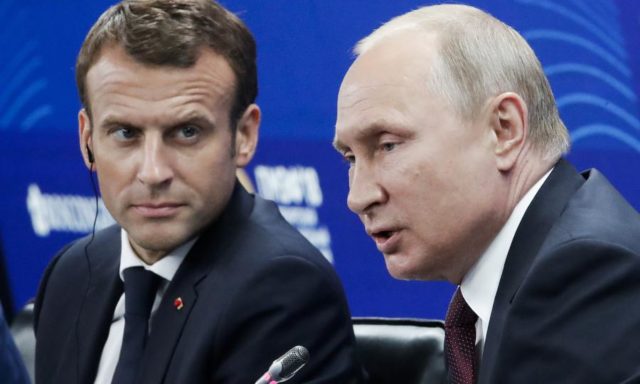
Regardless of the alliance’s alleged ‘brain dead’ status, it faces challenges from Turkey to the Baltic states
The North Atlantic Treaty Organization will meet in London in December to celebrate its 70th anniversary. Is it, as French President Emmanuel Macron has said, “brain dead,” and true that Europe can “no longer rely on America to defend NATO allies?”
The signs are ominous: recent actions by Turkey holding up NATO defense plans for Poland and the Baltic states, while France and Germany have been leading an effort to create a European alternative to NATO whose main attribute is to exclude the United States.
In February 2017, an article for the Italian think-tank Il Nodo di Gordio (The Gordian Knot) about NATO’s future titled “La NATO combatterà? E per cosa?” (Will NATO Fight, and for What?), made three main points that remain relevant today:
• NATO lacked key hardware and troops to defend Eastern Europe;
• NATO’s collective security system, based on Article 5 of the Washington Treaty, does not ensure that NATO will fight; and
• Some NATO members are unlikely to support the defense of Eastern European countries, especially the Baltic states and Poland.
Aside from the issues of spending and manpower, would Greece or Turkey support NATO in a fight far in the north where they have no interest and where they are, in any event, gravitating to the Russian orbit? Or would France or Germany want to risk the wrecking of their economies for a war they actually believed could have been avoided?
All the NATO members have approved the alliance’s defense proposal for the Baltic states and Poland – except Turkey. Turkey demands that NATO recognize the Syrian Kurdish militia known as the YPG – the People’s Protection Units – as a terror organization as a condition of its support. Under NATO rules, agreement must be unanimous, so Turkey’s attempt to attach unrelated conditions to its approval has ominous implications for the future of the alliance.
Side meetings at the December 70th Anniversary will take place among key NATO members to try to sort out the Turkish objections. While some sort of political solution may be found, this will only paper over the deeper rifts in the alliance – both political and structural.
Current NATO forces are woefully inadequate to deal with a Russian attack in the Baltic states or Poland. The Russians can count and surely know how the various conventional forces align. But what is often left out of the conversation is whether the NATO countries would respond to an attack at all, particularly in the context of provocations.
There are about a million Russians living as citizens in the Baltic states. About 27.6% of Latvia’s population is composed of ethnic Russians. Russians make up almost half of the population of Latvia’s capital, Riga, and in the second-largest city, Daugavpils, Russians make up the majority. In Estonia, 38.5% of Tallinn’s population is ethnic Russian. Vilnius, in Lithuania, is about 12% Russian, while overall the country is less than 5% Russian.
Last April, the president of Estonia, Kersti Kaljulaid (a known hardliner on Russia), met with Russian President Vladimir Putin on a visit to Moscow that caused a firestorm of criticism in the Baltic states. The visit appears to confirm that, at least in the eyes of the Estonian government, dialogue with Moscow is necessary. It is also recognition that the issue of the Bronze Soldier of Tallinn, which almost spiraled completely out of control, should not be repeated.
In 2007, the Bronze Soldier monument, erected by the Soviets in 1949 celebrating the victory over the Nazis, was moved by Estonia from its central location, and the graves of Russian soldiers buried alongside it either were moved to a local cemetery or, where possible, repatriated to Russia. Moscow viewed the changes as a hostile action against Russians living in Estonia and against Russia itself. In response, it carried out extensive cyberattacks against Estonia’s critical infrastructure, especially the financial sector and its military and intelligence organizations.
The latest argument between Moscow and Tallinn broke out on November 18 when Sergey Belyayev, the head of the Russian Foreign Ministry’s second European department, reiterated Moscow’s view that the 1920 Treaty of Tartu, in which Moscow recognized Estonia’s independence and agreed to a border, became null and void when Estonia became part of the Soviet Union in 1940. Estonia has been demanding that Russia live up to the Treaty of Tartu, which would require Moscow to return land to the east of Narva and the south of Lake Peipus, now part of Russia, representing about 5% of what was originally Estonia’s territory.
Estonia has no ability whatever to compel Russia to do anything, so the argument is just illustrative of claims made by Estonians and counterclaims made by Russians.
The Rand Corporation, which carried out war games to evaluate NATO’s defenses, concluded that NATO would be rapidly defeated, estimating that the longest it would take for Russian forces to reach the outskirts of the Estonian and/or Latvian capitals of Tallinn and Riga, respectively, would be 60 hours.
And that is if, in fact, NATO fought at all. But would it?
Today, given the problem of France and Germany, and the potential obstreperousness of Turkey and possibly Greece, no one knows the final answer. But it is likely it will be difficult to gain the consensus necessary for NATO action, which means the Russians would win by default.
Intellectuals and politicians in Europe and the United States have made wild claims about President Trump’s “lack of support” for NATO, largely based on his demands for other NATO countries to meet their financial obligations to the alliance. But the truth is that the danger zone for NATO is not the United States. Rather, it would appear, it is in the devolving politics of Europe and the dysfunctional role of a number of its members on the continent.

